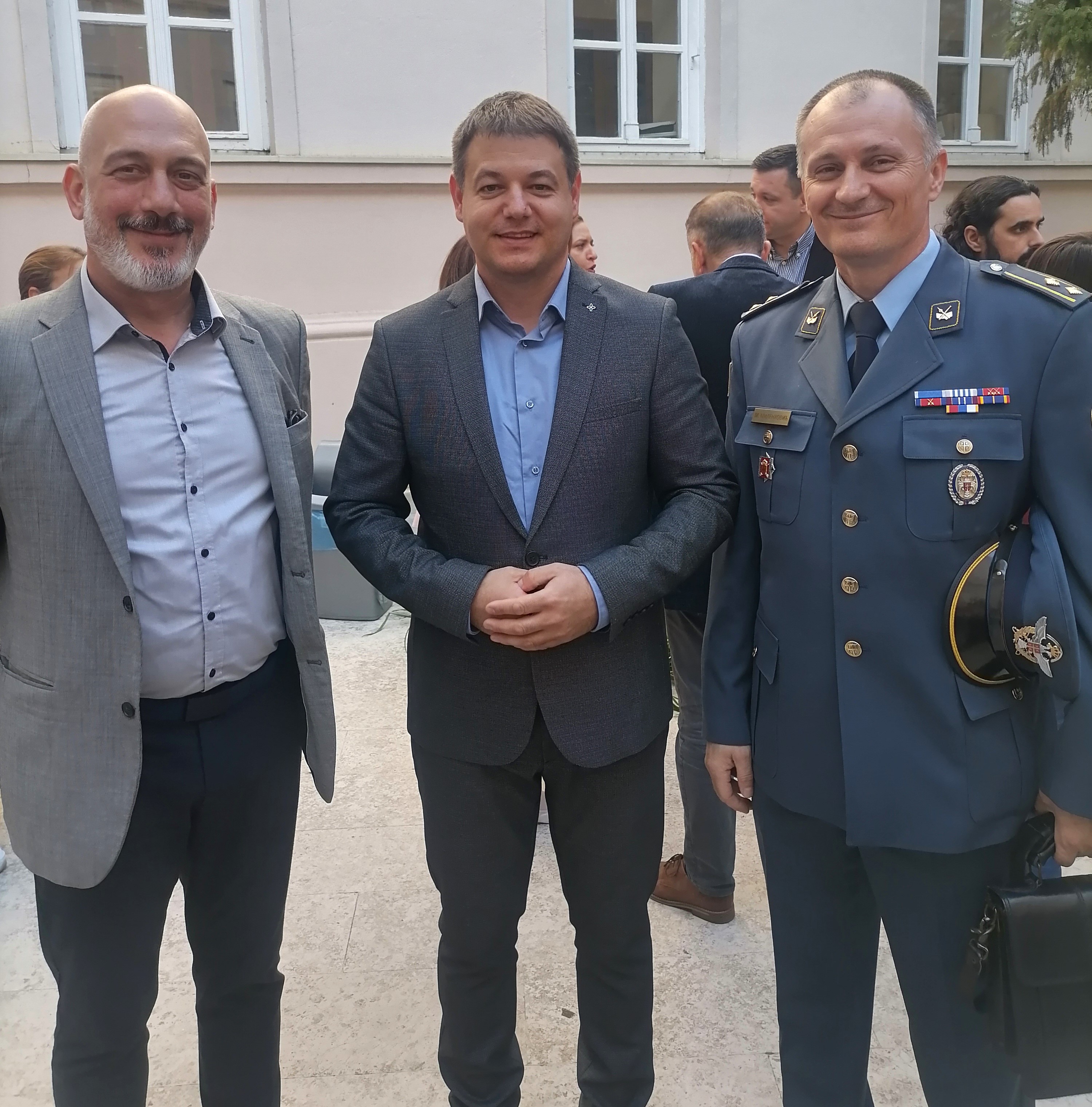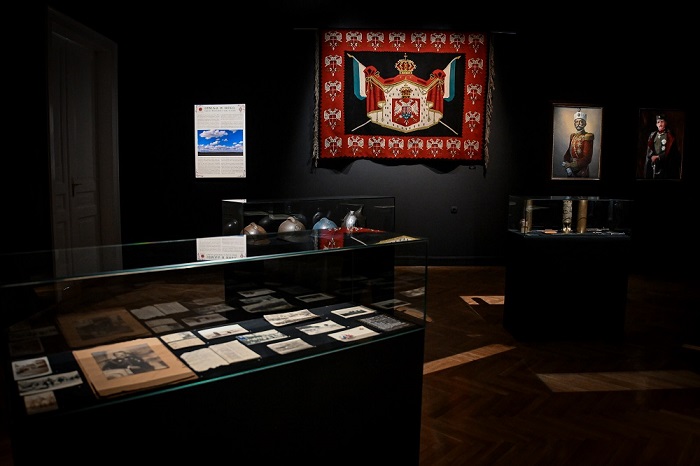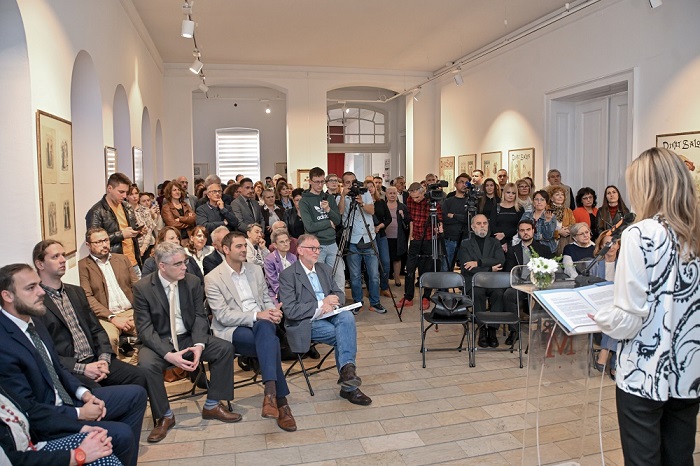30.10.2024
Celebrating the 177th anniversary of the Museum of Vojvodina
On Friday, October 25, the Museum of Vojvodina opened the exhibition "Earth and Sky - Serbian Vojvodina in the heart and soul", authored by Zoran Veljanović, archival adviser-curator historian and Dimitrij Mihajlović, curator historian, celebrated its 177th year of existence. They used this opportunity to thank all collaborators and friends, but also to remember all the activities of the previous year. The commemoration of the anniversary of the Museum of Vojvodina was attended by the members of the Aeronautical Museum, the director of the museum lieutenant colonel Miki Milenković, the head of the department for museum activities, senior curator Mirjana Novaković Munišević, and documentary curator Bojana Beuk, thus continuing the successfully started inter-institutional cooperation.

Along with the appropriate program and the opening of the exhibition, the guests were addressed by: Vera Kojić, Acting Undersecretary for Culture, Public Information and Relations with Religious Communities, Zoran Veljanović, the author of the exhibition and prof. Dr. Slobodan Bjelica. In her speech, Acting Director of the Museum of Vojvodina, Čarna Milinković, referred to the achievements so far, as well as the plans and goals towards which they will move in the coming period.

For years, the Museum of Vojvodina preserves and nurtures the heritage that inspires rich action in the future. The Museum of Vojvodina is one of the oldest, most important and largest museums in our country. Its beginnings, which represent the historical continuity of existence, can be traced in Budapest, where the Serbian Folk Collection was founded in 1826 thanks to a group of patriotic intellectuals. They had a desire to preserve the national culture of the Serbs in the territories of the Habsburg Monarchy, and from that desire, unconsciously or consciously, was born the vision that later created a museum institution. The most prominent person of that time was Sava Tekelija, a Hungarian nobleman of Serbian origin, who donated a large number of valuable objects to the Serbian National Collection. This collection grew into the Museum of Matica Srpska in 1933, and after the Second World War and new political circumstances, in 1947, into the Vojvodina Museum, founded by the Assembly of AP Vojvodina. The merger of the Vojvodina Museum and the Historical Museum of Vojvodina (the former Museum of the Revolution) in 1992 created today's Museum of Vojvodina as the largest complex museum in the Republic of Serbia and the second most important. In the Museum of Vojvodina, numerous objects are kept that represent the cultural treasures of Serbia and show the development of human society in the continuity of eight thousand years on today's land of Vojvodina.


Along with the appropriate program and the opening of the exhibition, the guests were addressed by: Vera Kojić, Acting Undersecretary for Culture, Public Information and Relations with Religious Communities, Zoran Veljanović, the author of the exhibition and prof. Dr. Slobodan Bjelica. In her speech, Acting Director of the Museum of Vojvodina, Čarna Milinković, referred to the achievements so far, as well as the plans and goals towards which they will move in the coming period.

For years, the Museum of Vojvodina preserves and nurtures the heritage that inspires rich action in the future. The Museum of Vojvodina is one of the oldest, most important and largest museums in our country. Its beginnings, which represent the historical continuity of existence, can be traced in Budapest, where the Serbian Folk Collection was founded in 1826 thanks to a group of patriotic intellectuals. They had a desire to preserve the national culture of the Serbs in the territories of the Habsburg Monarchy, and from that desire, unconsciously or consciously, was born the vision that later created a museum institution. The most prominent person of that time was Sava Tekelija, a Hungarian nobleman of Serbian origin, who donated a large number of valuable objects to the Serbian National Collection. This collection grew into the Museum of Matica Srpska in 1933, and after the Second World War and new political circumstances, in 1947, into the Vojvodina Museum, founded by the Assembly of AP Vojvodina. The merger of the Vojvodina Museum and the Historical Museum of Vojvodina (the former Museum of the Revolution) in 1992 created today's Museum of Vojvodina as the largest complex museum in the Republic of Serbia and the second most important. In the Museum of Vojvodina, numerous objects are kept that represent the cultural treasures of Serbia and show the development of human society in the continuity of eight thousand years on today's land of Vojvodina.

- Airplanes and helicopters
- Gliders and light aircraft
- Military aviation
- Civil Aviation
- Sports aviation
- NATO aggression
- Aircraft engines
- Aviation weapons
- Propellers and rotors
- Parachutes and equipment
- Training resources
- Clothing and accessories
- Equipment and tools
- Maquettes and models
- Photo library
- Aerial photographs
- Video and audio recordings
- Posters
- Art collection
- Philately

